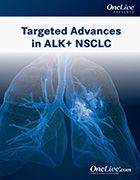Publication
Article
Updates in the ALK-Positive NSCLC Paradigm
Author(s):
Advanced, recurrent, and metastatic NSCLC is often associated with poor prognosis, and treatment is aimed to extend survival and provide symptom management.
Alexander Drilon, MD
Approximately 80% to 85% of lung cancer cases are NSCLC, the most common type of lung cancer.1 About 70% of patients with NSCLC have advanced disease (stage IIIB/IV) at the time of diagnosis, and 40% of these newly diagnosed patients with NSCLC have stage IV disease.2-3 Advanced, recurrent, and metastatic NSCLC (mNSCLC) is often associated with poor prognosis, and treatment is aimed to extend survival and provide symptom management.2,3
Advances in the understanding of distinct tumor biology and immunology have allowed the development of numerous targeted therapies and immune checkpoint inhibitors, which have improved overall survival (OS) in specific NSCLC populations. Molecular characterization has led to the definition of new subgroups of patients with distinct tumor biology who require specific treatments and strategies. Before the introduction of molecular targeted therapy, firstline treatment for advanced-stage NSCLC was limited to systemic cytotoxic chemotherapy and radiation therapy.2,3 During the discussion, Drilon highlighted the current landscape of molecular profiling for NSCLC, noting the migration that is influencing selection of “the best therapies for a patient, moving from just histology-based selection of cytotoxic chemotherapy to now utilizing a variety of molecular biomarkers and also immune biomarkers that inform our choice of first-line or later-line therapies.”
In the United States, about 20% of all NSCLC adenocarcinomas are characterized by oncogenic EGFR mutations (10% to 15%), ALK rearrangements (3% to 7%), BRAF mutations (2% to 5%), or ROS1 rearrangements (0.5% to 2%) that drive cancer growth.4-12 Drilon emphasized ALK positivity in NSCLC, stating, “We now know that ALK is embedded in the context of all of these other drivers, which have therapies that are either approved by 1 or more regulatory agencies [and] are in the NCCN guidelines, or [are in] clinical trials with very exciting activity.” There are current and emerging therapies for 6 key actionable driver mutations in NSCLC: EGFR (exon 19/21), ALK, BRAF V600E, ROS1, RET, and NTRK. Other driver oncogenes can be altered in NSCLC, including KRAS, HER2, and MET exon 14, and additional genotypes contribute to 50% of NSCLC diagnoses.3,13
Recommendations for Molecular Testing of ALK Positivity in NSCLC
Guideline recommendations across several organizations indicate the need for molecular and biomarker testing of tumor samples as part of the routine diagnostic process, prior to initiating therapy in the first-line setting, to guide treatment decisions (Table 1).13 At a minimum, NCCN guidelines recommendations indicate that patients must be tested for the oncogenic drivers—sensitizing EGFR alterations, ALK rearrangements, ROS1 gene rearrangements, BRAF V600E point mutations, and NTRK gene fusions—as well as PD-L1 tumor expression level.13 Drilon noted that the minimum recommended testing revolves around genetic mutations that are matched to targeted therapies approved by the FDA (Table 2).14-18 Many other emerging biomarkers are included in the NCCN guidelines, including MET exon 14 alterations, high-level MET amplification, RET fusions, and HER2 fusions, and data on tumor mutational burden are evolving. The NCCN guidelines include a strong recommendation that broad molecular profiling should be performed to identify rare driver mutations for which effective drugs may be available.13
Table 1. 2019 Guideline-Recommended Molecular Testing13 (Click to Enlarge)
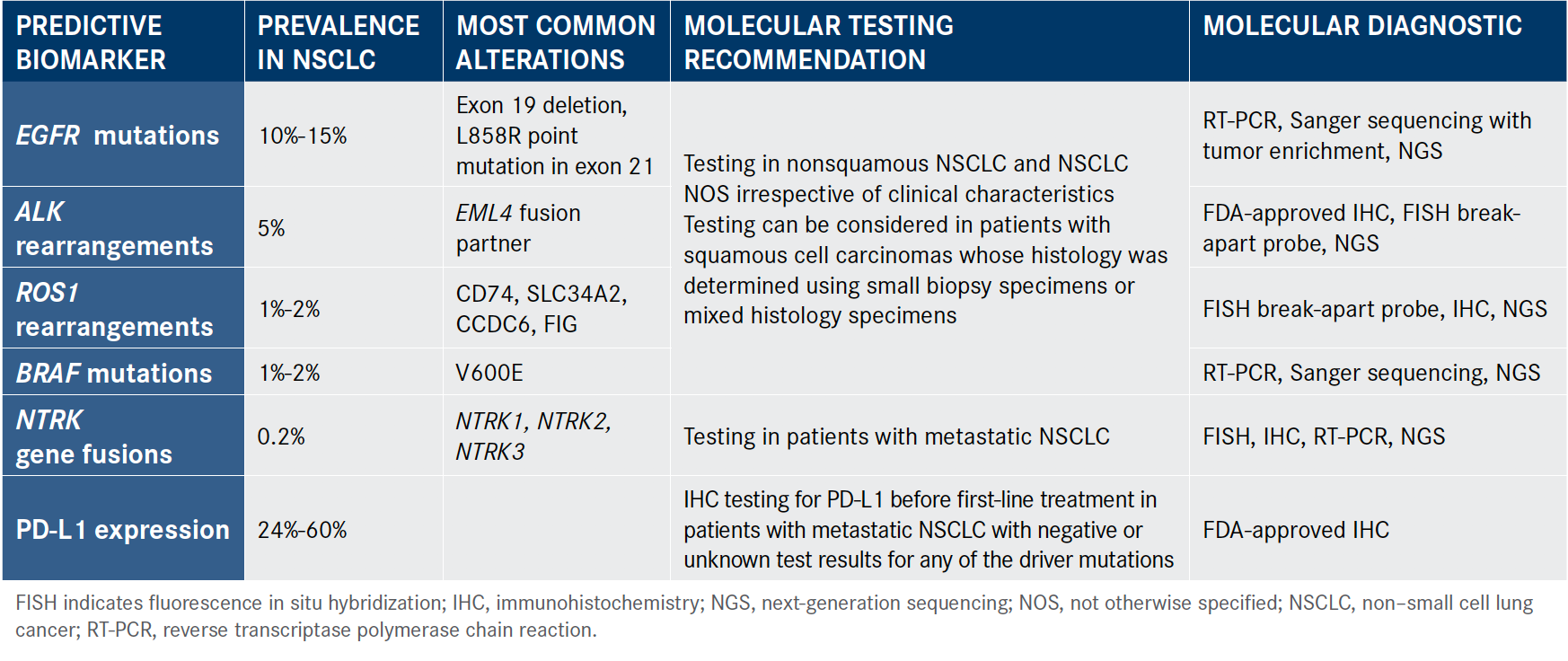
Testing for driver mutations is essential before initiating therapy in patients with NSCLC because there is a risk that the type of upfront treatment chosen may add toxicity and spur resistance to the targeted therapy option.20 Patients across each biomarker-defined subpopulation may respond differently to first-line TKI treatment due to tumor heterogeneity. These genetic abnormalities can predict drug sensitivity and primary or acquired resistance to TKIs, which can guide the selection of optimal second-line and subsequent therapies. Sensitizing ALK gene rearrangements are responsive to first-line pharmacological inhibition of ALK by TKIs such as alectinib, crizotinib, and ceritinib.2 While crizotinib is highly active, most patients treated with crizotinib ultimately develop resistance.21,22 Patients with ALK-positive NSCLC treated with an ALK inhibitor in the first line can still respond to another ALK inhibitor in the second and third lines.
Insight From Faculty in the Real-World Utilization of Molecular Testing
Table 2. Available ALK Tyrosine Kinase Inhibitors (TKI) and FDA Indications14-18 (Click to Enlarge)
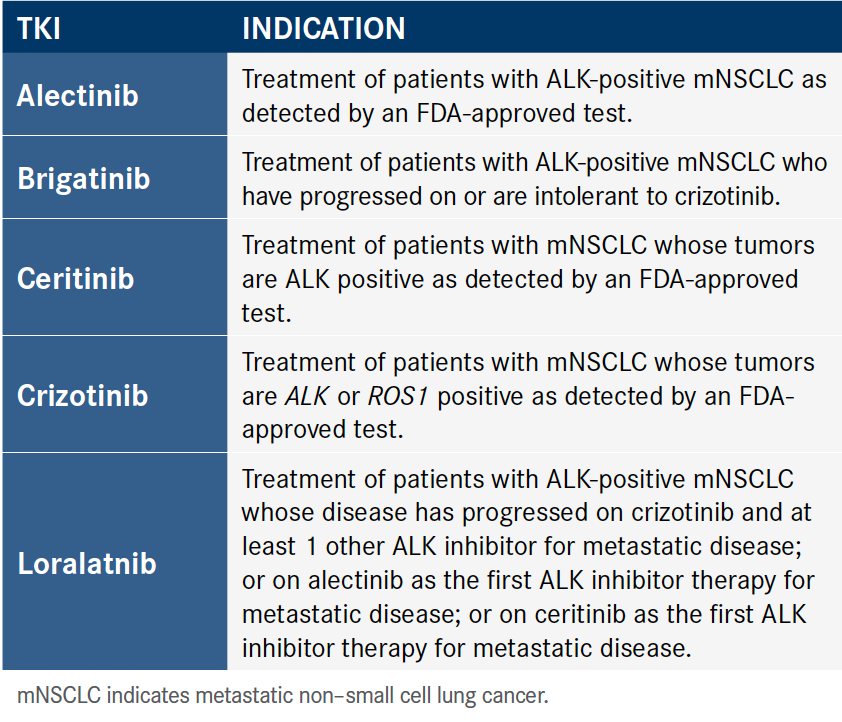
Balazs Halmos, MD, MS, director of the multidisciplinary thoracic oncology program for Montefiore Health Systems and director of clinical cancer genetics at Albert Einstein College of Medicine, indicated that if FISH is negative for ALK, NGS is the next step, as “kind of a nice backup. We had very few—but [still,] a few—misses. So it’s nice to have the NGS backup to catch patients where maybe the first [molecular] testing made some oversights.” Chul Kim, MD, MPH, a medical oncologist and assistant professor at Georgetown University, indicated that his institution has a tissue-based internal gene panel. “We check PD-L1, KRAS, EGFR, ALK, and BRAF…I see that most of the patients were tested for the single-gene panel testing. However, we are shifting more towards [an] NGS-based panel, because we can test multiple things at the same time,” he explained. “Because with the sequential testing, you’re using a lot of tissue for FISH and everything else. So we often get ‘quantity not sufficient’ when we send out tissue for NGS.”
Thomas Stinchcombe, MD, thoracic oncologist and professor of medicine at Duke University, stated that they “have a small 50-gene panel, which I think is insufficient, given the current landscape. Most of the time, we’re relying on Foundation Medicine as the major tester.”
Stinchcombe noted that variation exists at his institution, and he cited a potential challenge with the stepwise strategy in molecular testing methodologies. “I send everything en masse…but there is variation, even within our group, where some people do the quick screen on the internal test, and if that’s negative, then we’ll send out the broader panel with EGFR, ALK, ROS1,” he described. “Then if those 3 come back negative, they would refer to Foundation Medicine. But I think the problem with that is you consume the tissue, and you incur delays. And so I’m not sure how effective that strategy is going to be in the long term.”
Table 3. Changes to Recommended Treatment Strategies in Patients With Driver-Oncogenic Advanced NSCLC2,3,13,19 (Click to Enlarge)

Joshua Sabari, MD, a medical oncologist at NYU Langone Health, stated that “for adenocarcinomas, we’re reflexing the D5[F]3, and we’re also sending NGS panels at the same time…If we want to wait 6 weeks, we do a large 580-gene internal panel, or we’re sending out to Foundation Medicine. We get it back in 4 to 6 weeks. I send plasma, Guardant 360, on all patients I meet, irrespective of smoking or nonsmoking status, given some of the trials.”
The faculty expressed concern that if companies who provide sequencing—Foundation Medicine, Guardant, or others— package current NCCN guidelines with patient test results, it may persuade community oncologists to prescribe crizotinib over TKI inhibitors that have better efficacy. Said Fred Hirsch, MD, PhD, executive director of the Center for Thoracic Oncology in the Tisch Cancer Institute and professor of medicine at the Icahn School of Medicine, both at Mount Sinai, “I don’t think Foundation or other pathology departments or any other commercial labs should make that recommendation. It is a medical oncology thing to deal with the patient and find the right priorities.”
Contemporary Management of ALK-Positive NSCLC: Treatment-Naive Patients
Click to Enlarge
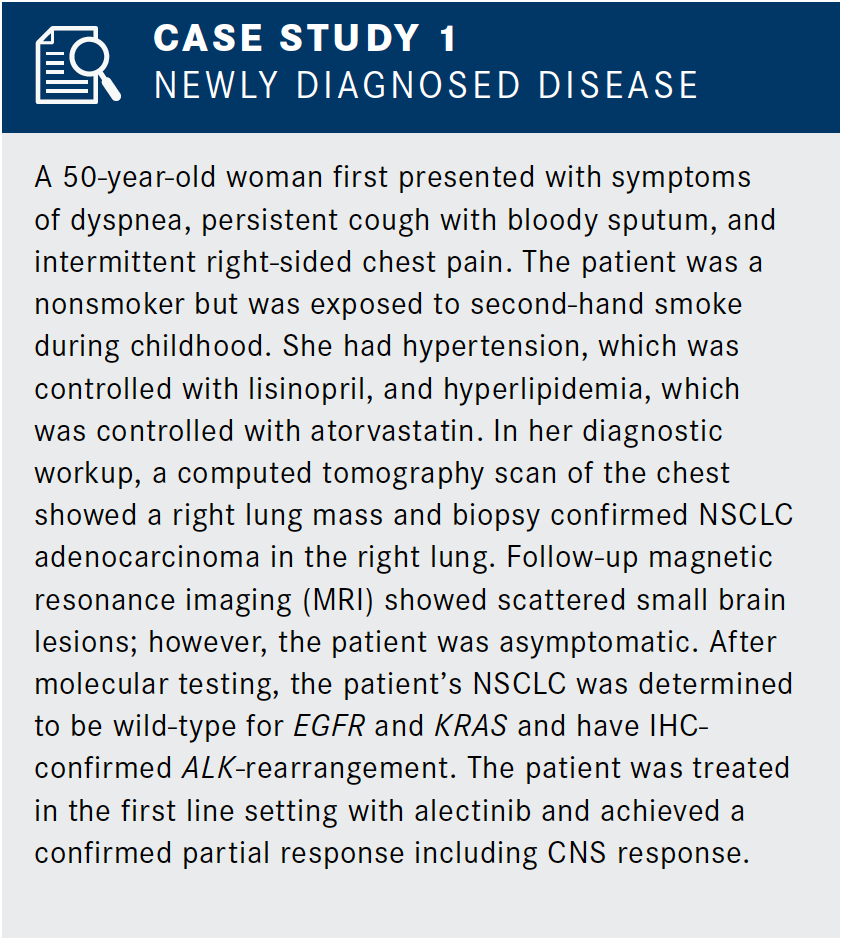
Table 4. Randomized Phase III Trials Evaluating ALK TKIs as First-Line Treatment for Advanced/Metastatic ALK-Rearranged NSCLC23-29 (Click to Enlarge)

The decision to use chemotherapy in the upfront setting is dependent on the patient’s oncogenic driver mutation status and if there is symptomatic disease. For example, for those who do not have molecular testing results back but require treatment immediately, the faculty agreed they would begin treatment with chemotherapy alone. Notably, faculty all agreed that in this setting, chemotherapy is preferred over empirically starting with a chemotherapy combination that includes an immune checkpoint inhibitor, especially pembrolizumab. Rotow said, “If the patient is really eager to get started [on treatment]…I actually will sometimes deliberately give that first cycle [of chemotherapy]…with the knowledge and discussion ahead of time that we’ll switch if something comes back on the panel.” Sabari agreed: “I do that as well. If they’re EGFR- and ALK IHC—negative, and we’re waiting for results, and they’re symptomatic, I’ll give them a dose of chemotherapy.”
Alectinib was agreed upon as the most appropriate firstline treatment in patients with treatment-naïve ALK-positive NSCLC. Faculty cited specific alectinib-associated adverse events (AEs) that require a medication switch to brigatinib, including grade 3/4 rash and platelet abnormalities. The switch to brigatinib was successful in practice settings where patients did not tolerate alectinib, with Haiying Cheng, MD, PhD, associate professor of oncology at Montefiore/ Albert Einstein College of Medicine, noting that “we switched to brigatinib without any problem.”
Despite the placement of crizotinib as a first-line treatment in the NCCN guidelines, its continued role as an option in the first-line setting was questioned by faculty during the Scientific Interchange. Overall, practice patterns have moved away from the use of crizotinib in the firstline setting, due to the results of several clinical trials that demonstrated survival benefits with the use of second-generation TKIs, including brigatinib. The shift is away from crizotinib, Drilon emphasized, stating, “We’re not seeing a difference in response rate dramatically if you go from TKI to TKI, early gen[eration] to next generation. But we are seeing differences in the median progression-free survival (PFS) when you go from crizotinib to these other agents. And the hazard ratios, of course, for PFS also look good and are significant when you have the randomized comparisons to crizotinib.”
Clinical Investigation of ALK Inhibitors in First-Line Treatment of ALK-Positive NSCLC
Attendees at the Scientific Interchange reviewed clinical efficacy and safety data for crizotinib, alectinib, and brigatinib, and they discussed the practical implications in treatment-naïve patients with ALK-positive NSCLC. Table 4 provides an overview of the pivotal phase III trials with ALK inhibitors.23-29 Following the results of the PROFILE 1014 trial with first-generation crizotinib, Drilon noted that the ALEX and ALTA-1 trials both posed the question of whether crizotinib is enough or if a next-generation TKI like alectinib or brigatinib would improve outcomes.
Phase III ALEX
Updated results from the phase III ALEX trial demonstrated the comparative efficacy and safety of alectinib in treatment-naïve patients with advanced ALK-rearranged NSCLC. Overall, compared with crizotinib, alectinib improved PFS, delayed CNS progression, and was better tolerated.24,25
Click to Enlarge
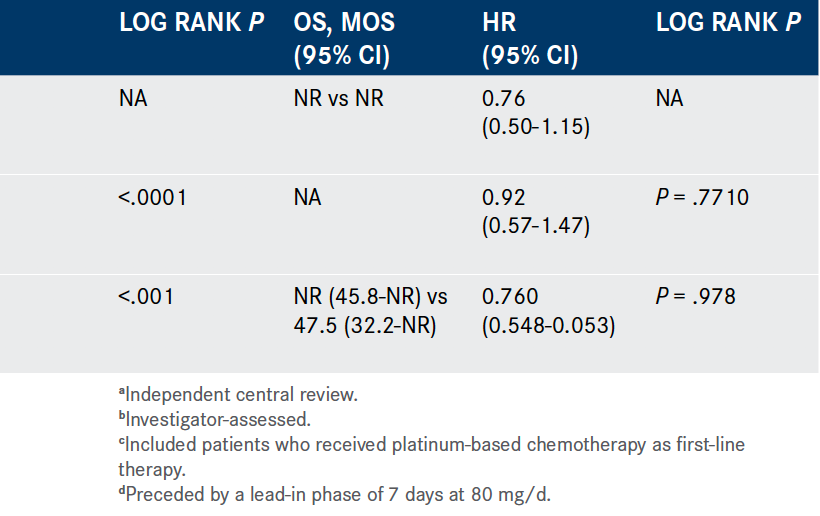
The median duration of follow-up was 27.8 months and 22.8 months for alectinib and crizotinib, respectively.24 For the primary end point of investigator-assessed PFS, patients given alectinib experienced longer PFS, with a median of 34.8 months compared with 10.9 months in those given crizotinib.24 For many subsets of patients, alectinib was favored over crizotinib, with the exceptions of active smokers and those with an ECOG performance status of 2.24
Of 43 patients with measurable CNS lesions at baseline, 81% of those given alectinib responded compared with 50% of those who received crizotinib, with complete responses in 38% and 5%, respectively.25 Among patients with measurable or unmeasurable CNS metastases at baseline, 76.6% of alectinib-treated patients had a partial response compared with 65.5% of crizotinib-treated patients. Patients treated with alectinib experienced a longer median duration of response than patients treated with crizotinib (33.1 vs 11.1 months, respectively). The cumulative incidence of CNS progression was lower with alectinib than crizotinib at 12 months (9.4% vs 41.4%, respectively).24
Fewer alectinib-treated patients experienced grade 3 to 5 AEs than their crizotinib-treated counterparts (44.7% vs 51.0%). Rates of serious AEs were similar among both groups (30.0% vs 30.5%, respectively). Lower rates of dose reductions (16.4% vs 20.5%) and dose interruptions (22.4% vs 25.2%) were reported in the alectinib arm compared with the crizotinib arm. The treatment discontinuation rate was 13.2% in both groups.24
Safety results from the ALEX trial were discussed by attendees, who also noted practice patterns for dose reductions of alectinib in patients with AEs. Sabari and Rotow mentioned case examples of transaminitis, where they continued treatment with alectinib after dose reduction. Saxena permanently discontinued alectinib in a patient who developed pneumonitis within 2 weeks of initiation; discontinuation was advised by the prescribing information. When discussing the possibility of dose reduction in the event of pneumonitis, the faculty considered 2 different approaches. Halmos acknowledged, “For pneumonitis, I haven’t had to do dose reductions. But I’ve done crossing over to other drugs. The cross-reactivity rates are unclear. And I’ve definitely seen patients tolerating another drug. I’ve done [a] dose reduction for…severe hepatitis. And I was able to dose re-escalate. But pneumonitis, it’s just such a lifethreatening— I wouldn’t dare to dose reduce. There are other drugs.” Rotow and Stinchcombe, however, would consider a dose reduction to 300 mg twice daily with close surveillance.
In patients who experience hyperglycemia as an AE, metformin and other diabetic agents have been given. Hyperglycemia was persistent after alectinib dose reduction, so the agents were continued. Faculty mentioned other non—doselimiting toxicities; they include fatigue and myalgia with creatine kinase elevation, especially in patients aged over 55 years.
Phase III ALTA-1L
ALTA-1L is an ongoing global, randomized, open-label, multicenter phase III trial investigating the safety and efficacy of brigatinib compared with crizotinib in 275 adult patients with ALK-positive, locally advanced or metastatic NSCLC who have not received prior treatment with an ALK inhibitor. Patients were randomized to receive brigatinib 180 mg once daily with a 7-day lead-in at 90 mg or crizotinib 250 mg twice daily.26
Results were presented during the Presidential Session at the European Society for Medical Oncology Asia Congress 2019. At the data cutoff for the second interim analysis (June 28, 2019), results from the ALTA-1L trial demonstrated that brigatinib is a potential treatment for adults with ALK-positive, locally advanced or metastatic NSCLC who are ALK TKI—naïve. Faculty attendees noted that the updated ALTA-1L data look similar to those from the ALEX trial.27
Brigatinib demonstrated consistent overall efficacy in the intention-to-treat population with a follow-up of 25 months. The investigator-assessed outcome calculated a 57% reduction in risk of disease progression or death in all patients taking brigatinib (HR, 0.43; 95% CI, 0.31-0.61), with a median PFS of 29.4 months with brigatinib (95% CI, 21.2- not reached) compared with 9.2 months with crizotinib (95% CI, 7.4-12.9).27-28
For the primary end point of blinded independent review committee (BIRC)-assessed PFS, brigatinib significantly improved PFS compared with crizotinib (HR, 0.49; 95% CI, 0.35-0.68; log-rank P <.0001), with a 51% decreased risk of disease progression or death. The median PFS assessed by BIRC was 24.0 months (95% CI, 18.5-not reached) for brigatinib and 11.0 months (95% CI, 9.2-12.9) for crizotinib.27-28
For the secondary end points, the confirmed objective response rate (ORR) per RECIST v1.1 was 74% (95% CI, 66%- 81%) for brigatinib and 62% (95% CI, 53%-70%) for crizotinib as assessed by BIRC. The median duration of response per BIRC was not reached (95% CI, 19 months to not evaluable) with brigatinib and was 14 months (95% CI, 9-21) with crizotinib.27
In patients with brain metastasis at baseline, brigatinib reduced the risk of intracranial disease progression or death by 69% (HR, 0.31, 95% CI, 0.17-0.56), with a median intracranial PFS of 24 months compared with 5.6 months with crizotinib, which Stinchcombe considered more a reflection of poor crizotinib efficacy than high brigatinib efficacy, because “6 months is a very poor PFS.” For patients with measurable brain metastases, brigatinib also achieved a confirmed intracranial ORR of 78% (95% CI, 52%-94%), while crizotinib achieved 26% (95% CI, 10%-48%). Brigatinib did not reach the median intracranial duration of response in confirmed responders (95% CI, 6 months to not evaluable), and crizotinib reached 9 months (95% CI, 4-9 months).27-28
While the data for CNS outcomes look favorable for brigatinib versus crizotinib, the faculty cautioned against comparing ALEX and ALTA-1L results. Drilon stated, “For the ALEX data, you saw the cumulative incidence diverge between crizotinib and alectinib. But then it was—the metric was different. It was PFS for brigatinib.”
During the ALTA-1L trial, the most common grade 3 or higher treatment-emergent AEs associated with brigatinib were increased creatine phosphokinase (24.3%), increased lipase (14.0%), and hypertension (11.8%); those most associated with crizotinib were increased alanine aminotransferase (10.2%), aspartate aminotransferase (6.6%), and lipase (6.6%). Pulmonary events at any time were experienced by 5.1% of patients receiving brigatinib and 2.2% receiving crizotinib. AEs led to treatment discontinuations in 12.5% of patients receiving brigatinib and 8.8% receiving crizotinib.27
While presenting the data to the rest of the faculty, Drilon highlighted the incidence of pneumonitis in brigatinib: “You’ll see that the frequency of early-onset interstitial lung disease or pneumonitis, within the first 2 weeks, was 3%. And the overall frequency of pneumonitis is 5%. So obviously, that was higher than [with] crizotinib and also higher if you look across trial comparisons [with] alectinib.” Drilon also noted that a higher proportion of patients given brigatinib required a dose reduction than those given alectinib in the ALEX trial: “If we look at the dose reductions due to AEs…[it’s] 38% versus 25% with brigatinib and crizotinib, [respectively]. If you look at the dose reduction rate of alectinib, it’s about 20%, or a little under 20%. We’re seeing maybe double the number of patients requiring a dose reduction with brigatinib versus alectinib.”
Given that the efficacy data, including PFS, looked similar between brigatinib and alectinib from the trials, some of the attendees agreed that the increased risk of pneumonitis was enough for them to prefer alectinib over brigatinib in the first-line setting. Pulmonary toxicity appeared to be the primary issue because the efficacy data are so similar, and it would be less of an issue if the ALTA-1L data were clearly superior to those of ALEX or if a head-to-head trial showed superiority of brigatinib versus alectinib.
With respect to payer coverage, attendees also expressed concern that they may have trouble getting lorlatinib covered as a second-line agent after brigatinib therapy, since lorlatinib was approved before the ALTA-1L trial data. Payer coverage of first-line alectinib versus brigatinib would also weigh into the decision. According to Kim, “The efficacy of alectinib versus brigatinib looks quite similar, although there’s numerical difference—I agree with that. But [by] hazard ratio, [it] looks pretty [much the] same. And then CNS response rate, about 80% for both. So, I think I’ll be having a hard time choosing between those [2 drugs] because we don’t have direct comparison[s]. If brigatinib is approved, and if [a] certain insurance [company] doesn’t approve 1 of the drugs, then I don’t have any problem using alectinib versus brigatinib if that’s the case.”
Contemporary Management of Patients With ALK-Positive NSCLC: Disease Progression
Approximately half of patients with ALK-positive mNSCLC on crizotinib therapy progress within 12 months.29 Resistance mechanisms that thwarted the first-generation ALK inhibitor crizotinib created the need for second- and third-generation ALK TKIs that could overcome such barriers.30 The second-generation ALK TKIs ceritinib, alectinib, and brigatinib target ALK L1196M and G1269A mutations, 2 of the most common mutations associated with crizotinib resistance.31 Results from several studies have demonstrated the efficacy of second- and third-generation ALK TKIs in CNS penetration and disease control.25,32-34
Clinical Investigation of ALK Inhibitors in Second-Line Treatment of ALK-Positive NSCLC
The ALTA trial established the differences in safety and efficacy of brigatinib in crizotinib-refractory ALK-positive NSCLC between 90 mg daily versus 180 mg daily with a 7-day lead in of 90 mg.32 Efficacy favored the higher dose, with an ORR of 54%, an intracranial ORR of 67% for patients with measurable brain metastases, PFS of 12.9 months, and an estimated 1-year OS of 80%.32 Drilon noted the comparative efficacy demonstrated in the ALTA trial: “I’ll say that if you look cross-trial against all of the other TKIs that were given in the postcrizotinib setting, we are seeing the longest PFSs with brigatinib, both in the CNS and extracranially.” However, he acknowledged that “the ORR [of] brigatinib post alectinib is 40% in [prospective] testing. But in a retrospective series from Memorial Sloan Kettering and Boston University, it was lower at 17%. So the response rate was lower if you look at the 2 different series.”
In the ASCEND-9 trial, a single-arm, open-label, multicenter phase II study in Japan, patients (N = 20) had histologically or cytologically confirmed stage IIIB or IV ALK-positive NSCLC with progression on prior alectinib therapy; the ORR with ceritinib 750 mg daily was 25% with 1 complete response.34 According to Drilon, this demonstrates “what happens in patients who get alectinib in the first-line setting…The response rate is decent, 25%, but obviously not in the 60%-to-80% range.”
In a global, single-arm, open-label, multicenter phase II study, patients with mNSCLC (N = 275) were enrolled in 6 expansion cohorts on the basis of both rearrangement gene status (either an ALK or ROS1) and prior treatment with ALK TKI therapy (up to 3 of the following: alectinib, brigatinib, ceritinib, crizotinib, ensartinib, or entrectinib). Patients across all cohorts were administered lorlatinib 100 mg daily in 21-day cycles.33 “The response rate was 48%,” reported Drilon. “It’s about 40% in crizotinib plus another ALK inhibitor, 30% in patients post alectinib, 46% in patients post ceritinib. And then, of course, we know that lorlatinib also works well in the CNS.”
Click to Enlarge
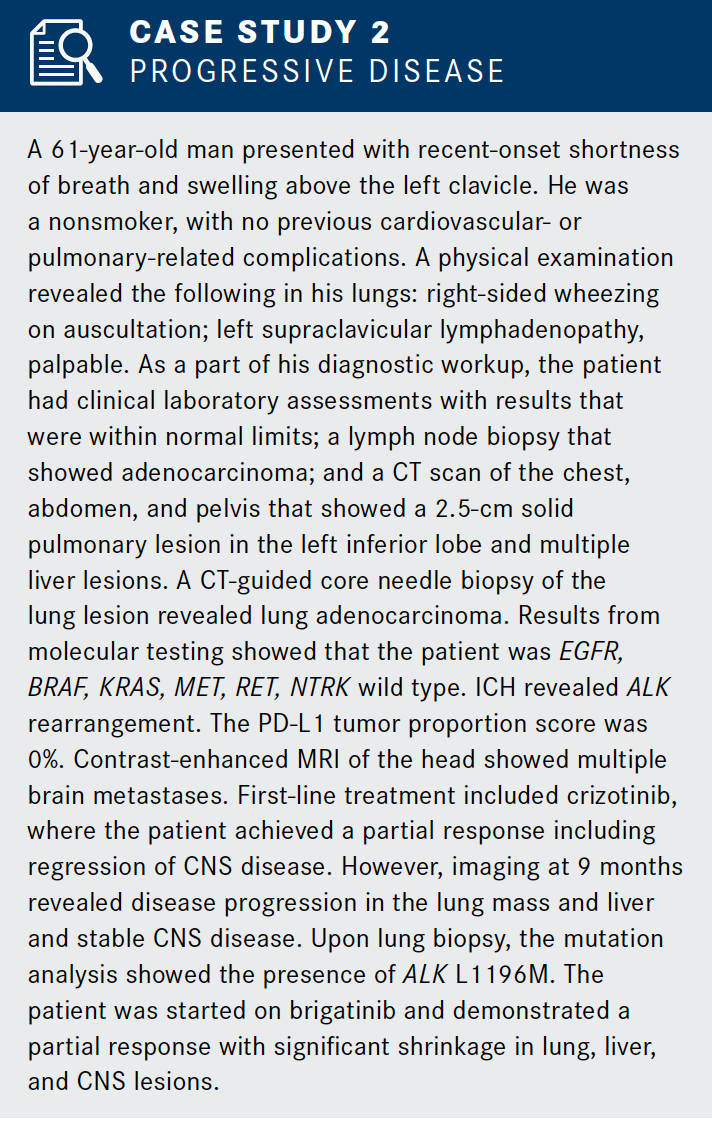
For patients who develop a gatekeeper L1196M mutation after initial treatment with crizotinib, the faculty agreed that either brigatinib or lorlatinib would be a reasonable choice. The selection of brigatinib for this patient was appropriate, as alectinib would not have efficacy within the population with a L1196 mutation, based on preclinical data. For a G1202R mutation, lorlatinib would be most appropriate.
If the patient showed echinoderm microtubule—associated protein-like ALK and high-level MET amplification without an ALK mutation, the faculty would consider a second ALK inhibitor or chemotherapy, depending on the timing of retest and how sick the patient is. If a driver is not identified in the resistance setting after alectinib, the attendees agreed that lorlatinib would be their second-line treatment of choice.
Insight From Faculty Regarding Strategies for Sequencing TKIs
For patients who progress on alectinib, lorlatinib is preferred. Based on the emerging prospective phase II data, brigatinib is promising in the postalectinib setting
The attendees expressed conflicting opinions on the next steps in the prior TKI setting, if a patient was ALK-mutation negative on repeat profiling. Some would repeat profiling, citing the low sensitivity of the assays, while others would start a chemotherapy regimen like carboplatin/pemetrexed.
Drilon commented, “Lots of sort of confusing data in the second-line TKI space.” He asked attendees if there were any data gaps for patients who have been exposed to prior TKI therapy or whether there were any additional trials they would like to run to help determine optimal sequencing strategies in these patients. Hirsch replied, “I think you’re asking, ‘What do we need?’ I think we need more data post alectinib. That is what we need.”
The attendees expressed interest in the outcomes of the National Cancer Institute—NRG ALK Master Protocol. According to Stinchcombe, it will “triage patients based on their specific mutation. They’re sort of retrospective in small case series of this. And this will prospectively compare G1202R lorlatinib versus brigatinib. It has an L119—you’d have to see if you can reuse crizotinib. Then it has the MET amplification resistance mechanism. Then I’d say the third cohort is the people who are mutation-negative. They’re going to compare an ALK TKI versus chemotherapy.”
Roy Herbst, MD, PhD, chief of medical oncology at Yale Cancer Center and Smilow Cancer Hospital, said, “I think as a takeaway from this, I’d love to see a very nice chart of the different mutations and what drug one could use, and that needs to be available to everyone, because right now, I’ve seen the Foundation Medicine reports. And I get calls from some of our community physicians who use [those]. They don’t know which drug to use based on the mutation they get. So I think some sort of roadmap would be good. And the third thing, I was glad to hear the Master Protocol [is] moving forward.”
References
- What is lung cancer? / non—small cell lung cancer. American Cancer Society website. cancer.org/cancer/non-small-cell-lung-cancer/about/whatis- non-small-cell-lung-cancer.html. Updated October 1, 2019. Accessed December 10, 2019.
- Novello S, Barlesi F, Califano R, et al; ESMO Guidelines Committee. Metastatic non-small-cell lung cancer: ESMO Clinical Practice Guidelines for diagnosis, treatment and follow-up. Ann Oncol. 2016;27(suppl 5):v1-v27. doi: 10.1093/annonc/ mdw326.
- Non-small cell lung cancer treatment (PDQ): health professional version. National Cancer Institute website. cancer.gov/types/lung/hp/non-small-cell-lung-treatment-pdq. Updated June 13, 2019. Accessed February 18, 2020.
- Pao W, Girard N. New driver mutations in non-small-cell lung cancer. Lancet Oncol. 2011;12(2):175-180. doi: 10.1016/S1470-2045(10)70087-5.
- Farago AF, Azzoli CG. Beyond ALK and ROS-1: RET, NTRK, EGFR and BRAF gene rearrangements in non-small cell lung cancer. Transl Lung Cancer Res. 2017;6(5):550-559. doi: 10.21037/tlcr.2017.08.02.
- Sharma SV, Bell DW, Settleman J, Haber DA. Epidermal growth factor receptor mutations in lung cancer. Nat Rev Cancer. 2007;7(3):169-181. doi: 10.1038/nrc2088.
- Dagogo-Jack I, Shaw AT. Crizotinib resistance: implications for therapeutic strategies. Ann Oncol. 2016;27(suppl 3):iii42-iii50. doi: 10.1093/ annonc/mdw305.
- Patel JN, Ersek JL, Kim ES. Lung cancer biomarkers, targeted therapies and clinical assays. Transl Lung Cancer Res. 2015;4(5):503-514. doi: 10.3978/j.issn.2218- 6751.2015.06.02.
- Solomon BJ, Bauer TM, Felip E, et al. Safety and efficacy of lorlatinib (PF- 06463922) from the dose-escalation component of a study in patients with advanced ALK+ or ROS-1+ non-small cell lung cancer (NSCLC). J Clin Oncol. 2016;34(suppl 15):9009. doi: 10.1200/JCO.2016.34.15_suppl.9009.
- Gainor JF, Varghese AM, Ou SH, et al. ALK rearrangements are mutually exclusive with mutations in EGFR or KRAS: an analysis of 1,683 patients with non-small cell lung cancer. Clin Cancer Res. 2013;19(15):4273- 4281. doi: 10.1158/1078-0432.CCR-13-0318.
- Koivunen JP, Mermel C, Zejnullahu K, et al. EML4-ALK fusion gene and efficacy of an ALK kinase inhibitor in lung cancer. Clin Cancer Res. 2008;14(13):4275-4283. doi: 10.1158/1078-0432.CCR-08-0168.
- Wong DW, Leung EL, So KK, et al; University of Hong Kong Lung Cancer Study Group. The EML4-ALK fusion gene is involved in various histologic types of lung cancers from nonsmokers with wild-type EGFR and KRAS. Cancer. 2009;115(8):1723-1733. doi: 10.1002/cncr.24181.
- NCCN Clinical Practice Guidelines in Oncology. Non-Small Cell Lung Cancer, version 1.2020. National Comprehensive Cancer Network website. nccn.org/ professionals/physician_gls/pdf/nscl.pdf. Published November 6, 2019. Accessed February 18, 2020.
- Xalkori [prescribing information]. New York, NY: Pfizer; 2019. labeling. pfizer.com/ShowLabeling.aspx?id=676. Accessed February 18, 2020.
- Alecensa [prescribing information]. South San Francisco, CA: Genentech; 2018. gene.com/download/pdf/alecensa_prescribing.pdf. Accessed February 18, 2020.
- Alunbrig [prescribing information]. Cambridge, MA: ARIAD Pharmaceuticals; 2018. alunbrig.com/assets/pi.pdf. Accessed February 18, 2020.
- Zykadia [prescribing information]. East Hanover, NJ: Novartis; 2019. pharma. us.novartis.com/sites/www.pharma.us.novartis.com/files/zykadia. pdf. Accessed February 18, 2020.
- Lorbrena [prescribing information]. New York, NY: Pfizer; 2018. labeling. pfizer.com/ShowLabeling.aspx?id=11140. Accessed February 18, 2020.
- Lindeman NI, Cagle PT, Aisner DL, et al. Updated molecular testing guideline for the selection of lung cancer patients for treatment with targeted tyrosine kinase inhibitors: guideline from the College of American Pathologists, the International Association for the Study of Lung Cancer, and the Association for Molecular Pathology. Arch Pathol Lab Med. 2018;142(3):321-346. doi: 10.5858/ arpa.2017-0388-CP.
- Ramalingam S. Choosing the best first-line therapy: oncogene-driven NSCLC. Presented at: 14th Annual New York Lung Cancers Symposium; November 9, 2019; New York, NY.
- Mezquita L, Planchard D. The role of brigatinib in crizotinib-resistant non-small cell lung cancer. Cancer Manag Res. 2018;10:123-130. doi: 10.2147/ CMAR.S129963.
- Gainor JF, Shaw AT, Sequist LV, et al. EGFR mutations and ALK rearrangements are associated with low response rates to PD-1 pathway blockade in non-small cell lung cancer: a retrospective analysis. Clin Cancer Res. 2016;22(18):4585-4593. doi: 10.1158/1078-0432.CCR-15-3101.
- McCusker MG, Russo A, Scilla KA, et al. How I treat ALK-positive nonsmall cell lung cancer. ESMO Open. 2019;4(suppl 2):e000524. doi: 10.1136/esmoopen-2019-000524.
- Camidge DR, Dziadziuszko R, Peters S, et al. Updated efficacy and safety data and impact of the EML4-ALK fusion variant on the efficacy of alectinib in untreated ALK-positive advanced non—small cell lung cancer in the global phase III ALEX study. J Thorac Oncol. 2019;14(7):1233-1243. doi: 10.1016/j.jtho.2019.03.007.
- Peters S, Camidge DR, Shaw AT, et al; ALEX Trial Investigators. Alectinib versus crizotinib in untreated ALK-positive non-small-cell lung cancer. N Engl J Med. 2017;377(9):829-838. doi: 10.1056/NEJMoa1704795.
- Camidge DR, Kim HR, Ahn MJ, et al. Brigatinib versus crizotinib in ALK-positive non-small-cell lung cancer. N Engl J Med. 2018;379(21):2027-2039. doi: 10.1056/NEJMoa1810171.
- Camidge R, Kim HR, Ahn M-J, et al. Brigatinib vs crizotinib in patients with ALK inhibitor-naive advanced ALK+ NSCLC: updated results from the phase III ALTA-1L trial. Ann Onc. 2019;30(suppl 9):ix195-ix196. doi: 10.1093/annonc/mdz446.
- Camidge DR, Kim HR, Ahn M, et al. Brigatinib vs crizotinib in patients with ALK inhibitor-naive advanced ALK+ NSCLC: updated results from the phase III ALTA-1L trial. Oral presentation at: ESMO Asia; November 23, 2019; Singapore.
- Solomon BJ, Kim DW, Wu YL, et al. Final overall survival analysis from a study comparing first-line crizotinib versus chemotherapy in ALK-mutation- positive non-small-cell lung cancer. J Clin Oncol. 2018;36(22):2251- 2258. doi: 10.1200/JCO.2017.77.4794.
- Katayama R, Shaw AT, Khan TM, et al. Mechanisms of acquired crizotinib resistance in ALK-rearranged lung cancers. Sci Transl Med. 2012;4(120):120ra17. doi: 10.1126/scitranslmed.3003316.
- Lin JJ, Riely GJ, Shaw AT. Targeting ALK: precision medicine takes on drug resistance. Cancer Discov. 2017;7(2):137-155. doi: 10.1158/2159-8290. CD-16-1123.
- Kim DW, Tiseo M, Ahn MJ, et al. Brigatinib in patients with crizotinib-refractory anaplastic lymphoma kinase-positive non-small-cell lung cancer: a randomized, multicenter phase II trial. J Clin Oncol. 2017;35(22):2490- 2498. doi: 10.1200/ JCO.2016.71.5904.
- Solomon BJ, Besse B, Bauer TM, et al. Lorlatinib in patients with ALK-positive non-small-cell lung cancer: results from a global phase 2 study. Lancet Oncol. 2018;19(12):1654-1667. doi: 10.1016/S1470- 2045(18)30649-1.
- Hida T, Seto T, Horinouchi H, et al. Phase II study of ceritinib in alectinib- pretreated patients with anaplastic lymphoma kinase-rearranged metastatic non-small-cell lung cancer in Japan: ASCEND-9. Cancer Sci. 2018;109(9):2863-2872. doi: 10.1111/cas.13721.
During a discussion of best practices in the selection of TKI therapy, attendees agreed that the next step after treatment failure with TKI should be molecular profiling with ctDNA from plasma, and if that is negative, to follow up with a tissue biopsy.
Patients with stage IIIB/IV, ALK-positive NSCLC were randomized to first-line treatment with alectinib 600 mg twice a day (n = 152) or crizotinib 250 mg twice daily (n = 151).24 Approximately 40% of patients in each treatment group presented with CNS metastases at baseline, and just over half were of non-Asian ethnicity.24
In discussing this case study, Rotow noted, “I’d routinely start with just a TKI for small asymptomatic [brain] lesions.” For patients with an asymptomatic brain lesion 3 cm or larger, initial surgery may be recommended, followed by TKI treatment. Depending on where the mass is located, faculty suggested that treatment with a TKI alone would be appropriate. No members of the faculty would recommend radiation in the upfront setting.
Faculty at the Scientific Interchange explored factors influencing the selection of a TKI in patients with treatment-naïve ALK-positive NSCLC through discussion of a case study (Case Study 1).
ctDNA was cited by most faculty as a selectively incorporated molecular testing method. Tissue-based testing can be challenging to implement as it is limited by tissue quantity and timing for return of results. Halmos indicated that ctDNA is useful “when there are timing problems—when somebody is super sick, and there’s a question of whether a tissue-based testing will come back in time.” Julia Rotow, MD, a medical oncologist at Dana-Farber Cancer Institute, emphasized the ctDNA perspective: “I think as others have said, I send it selectively for patients who either have a high pretest prob-ability, concern about the adequacy of the tissue sample for actual NGS results, or if I think there’s an urgent clinical need where a patient can’t wait the extra 10 days for the ctDNA sequentially.” For ctDNA-based molecular testing, several faculty noted their reliance on the Guardant platform, given its comparatively shorter turnaround time for results.
Faculty engaged in a discussion regarding molecular test-ing practices across their institutions, demonstrating the lack of a standardized approach. Immunohistochemistry (IHC), followed by fluorescence in situ hybridization (FISH), are used by the majority of attendees as the initial ALK, ROS1, and KRAS testing methodologies. Small panel testing for EGFR, ALK, and KRAS is conducted and results are available within 3 days. Ashish Saxena, MD, PhD, assistant professor of thoracic oncology, Weill Cornell Medicine, noted that the panel at his institution has replaced FISH as a follow-up for negative IHC. “For ALK…we have a larger panel, which is an OncoLine panel,” he said. “It’s about 150-plus [genes and] counting. And that includes ALK [fusions] and…hot spots for amplifications. It picks up all of those. Just very recently they made that reflexive.” As several larger gene panels for molecular testing have become more readily accessible, institutions have adopted different methods, such as next-generation sequencing (NGS)-based panels. However, these methods may be limited by availability of tissue, and some faculty question the usefulness of these methodologies.
TKIs are indicated in the first-line and subsequent treatment settings for patients with advanced NSCLC harboring oncogenic driver alterations (Table 3).2,3,13,19 ROS1, BRAF V600E, EGFR, and ALK molecular genetic abnormalities serve as predictive biomarkers of therapeutic response and are used to guide appropriate TKI treatment choice and subsequent guideline-recommended regimens.
